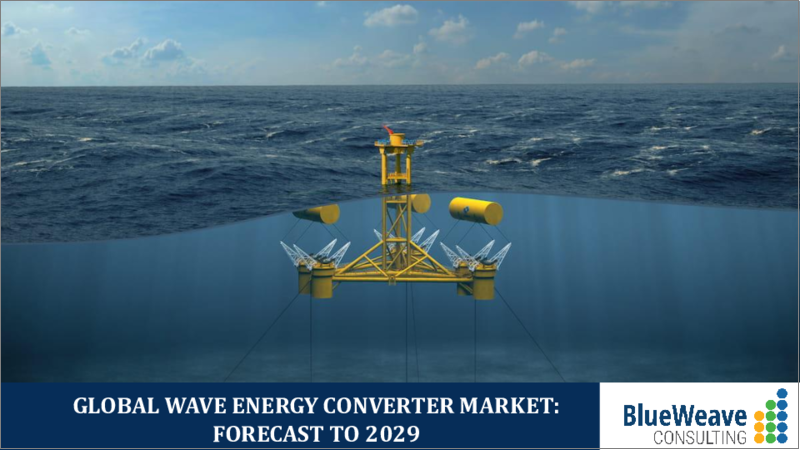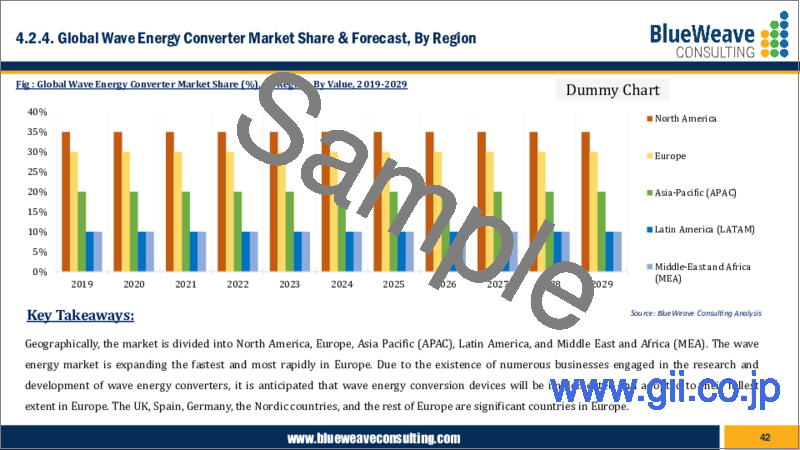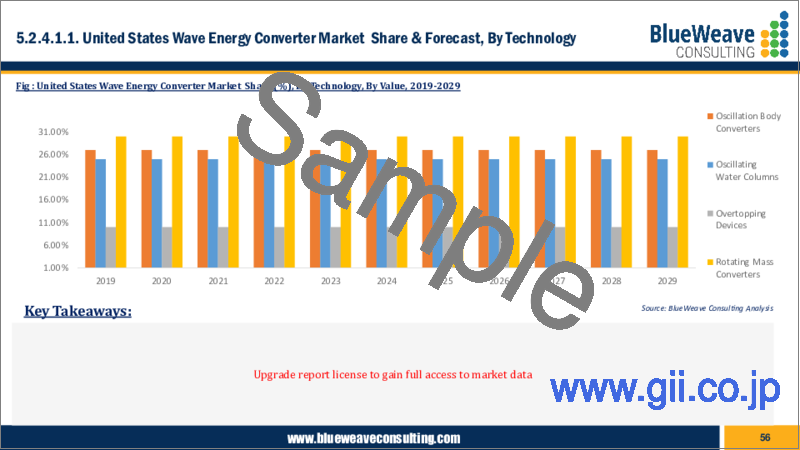|
|
市場調査レポート
商品コード
1166146
波力エネルギー変換器の世界市場 - 規模・シェア・動向分析・機会・予測:技術別、場所別、用途別、地域別(2018年~2028年)Wave Energy Converter Market - Global Size, Share, Trend Analysis, Opportunity and Forecast Report, 2018-2028, Segmented By Technology, By Location, By Application, By Region |
||||||
| 波力エネルギー変換器の世界市場 - 規模・シェア・動向分析・機会・予測:技術別、場所別、用途別、地域別(2018年~2028年) |
|
出版日: 2022年11月07日
発行: Blueweave Consulting
ページ情報: 英文 240 Pages
納期: 2~3営業日
|
- 全表示
- 概要
- 目次
世界の波力エネルギー変換器の市場規模は、2022年から2028年の予測期間中に24.1%の好調なCAGRで成長し、2028年には1億8,560万米ドルに達すると予想されています。市場の成長を後押しする主な要因には、再生可能エネルギー源からの電力需要の増加、波力エネルギーの幅広い利用可能性、革新的な波力エネルギー変換器技術への投資の増加などが挙げられます。
当レポートでは、世界の波力エネルギー変換器市場を調査しており、市場の概要、市場規模や予測、動向、促進要因・抑制要因、技術別・場所別・用途別・地域別の分析、および企業プロファイルなどの包括的な情報を提供しています。
目次
第1章 調査の枠組み
第2章 エグゼクティブサマリー
第3章 世界の波力エネルギー変換器市場の洞察
- 業界バリューチェーン分析
- DROC分析
- 成長促進要因
- 沿岸地域からの電力需要の増加
- 手軽で豊富な波力エネルギー源
- 抑制要因
- 多額の設備投資と不十分なインフラストラクチャ
- 機会
- 再生可能エネルギー分野における政府のイニシアチブと投資
- 技術開発
- 課題
- 中央グリッドへの接続の欠如
- 環境規制とライセンシング手続きに関する不確実性
- 成長促進要因
- 技術の進歩/最近の開発
- 規制の枠組み
- ポーターのファイブフォース分析
- 供給企業の交渉力
- 買い手の交渉力
- 新規参入業者の脅威
- 代替品の脅威
- 競争の激しさ
第4章 世界の波力エネルギー変換器市場概要
- 市場規模と予測:金額別(2018年~2028年)
- 金額別
- 市場シェアと予測
- 技術別
- 振動物体型
- 振動水柱型
- 越波型
- 回転質量変換器
- 場所別
- ニアショア
- ショアライン
- オフショア
- 用途別
- 発電
- 海水淡水化
- 水の汲み上げ
- 環境保護
- 地域別
- 北米
- 欧州
- アジア太平洋
- ラテンアメリカ
- 中東・アフリカ
- 技術別
第5章 北米の波力エネルギー変換器市場
- 市場規模と予測:金額別(2018年~2028年)
- 金額別
- 市場シェアと予測
- 技術別
- 場所別
- 用途別
- 国別
- 米国
- カナダ
第6章 欧州の波力エネルギー変換器市場
- 市場規模と予測:金額別(2018年~2028年)
- 金額別
- 市場シェアと予測
- 技術別
- 場所別
- 用途別
- 国別
- ドイツ
- デンマーク
- 英国
- イタリア
- フランス
- スペイン
- オランダ
- ベルギー
- 北欧諸国
- その他の欧州
第7章 アジア太平洋の波力エネルギー変換器市場
- 市場規模と予測:金額別(2018年~2028年)
- 金額別
- 市場シェアと予測
- 技術別
- 場所別
- 用途別
- 国別
- 中国
- インド
- 日本
- 韓国
- オーストラリア・ニュージーランド
- インドネシア
- マレーシア
- シンガポール
- フィリピン
- ベトナム
- その他のアジア太平洋
第8章 ラテンアメリカの波力エネルギー変換器市場
- 市場規模と予測:金額別(2018年~2028年)
- 金額別
- 市場シェアと予測
- 技術別
- 場所別
- 用途別
- 国別
- ブラジル
- メキシコ
- アルゼンチン
- ペルー
- コロンビア
- その他のラテンアメリカ
第9章 中東・アフリカの波力エネルギー変換器市場
- 市場規模と予測:金額別(2018年~2028年)
- 金額別
- 市場シェアと予測
- 技術別
- 場所別
- 用途別
- 国別
- サウジアラビア
- アラブ首長国連邦
- カタール
- クウェート
- イラン
- 南アフリカ
- ナイジェリア
- ケニア
- エジプト
- モロッコ
- アルジェリア
- その他の中東・アフリカ
第10章 競合情勢
- 主要企業とその製品リスト
- 世界の波力エネルギー変換器企業の市場シェア分析、2021年
- 運用パラメータ別の競合ベンチマーキング
- 主要な戦略的展開(合併、買収、パートナーシップなど)
第11章 世界の波力エネルギー変換器市場へのCOVID-19の影響
第12章 企業プロファイル(企業概要、財務マトリックス、競合情勢、主要な人材、主要な競合、連絡先住所、および戦略的展望)
- Ocean Power Technologies
- ECO Wave Power
- Corpower Ocean
- Wello OY
- Calwave Power Technologies
- AW-Energy OY
- Carnegie Clean Energy
- Sinn Power
- Amog Consulting
- Nemos GmbH
- Oceanenergy
- Wave Swell
- AWS Ocean Energy
- Hann-Ocean Energy
- Accumulated Ocean Energy
- その他の有力企業
第13章 主要な戦略的推奨事項
第14章 調査手法
Global Wave Energy Converter Market Size Accelerating at High CAGR of 24.1% during 2022-2028
Global wave energy converter market is flourishing owing to an increasing demand for electricity from renewable energy sources, wide availability of wave energy, and increasing investments in innovative wave energy converter technologies.
BlueWeave Consulting, a leading strategic consulting and market research firm, in its recent study, expects the size of global wave energy converter market to grow at an impressive CAGR of 24.1% during the forecast period between 2022 and 2028. BlueWeave forecasts global wave energy converter market size to reach a value of USD 185.6 million by 2028. The global wave energy converter market is benefiting from the rising demand for electricity from renewable energy sources and the growing accessibility of wave energy supply, which has further led to an increase in investments within the industry. The up-and-down motion of ocean waves results in the generation of wave energy. Wave energy generators are used to extract the wave energy from the ocean waves, which is then used to power turbines and generators to create electricity. As the wave energy industry is still in its early stages, it is expected to see significant investments in research and development activities. The increase in research and development activities is expected to make processes more efficient and cost-effective, thereby assisting market growth.
Global Wave Energy Converter Market - Overview
The energy contained in ocean waves is captured and used to generate electricity by a wave energy converter. It is an effective technology that makes use of the enormous renewable energy found in ocean waves. The wave energy converter absorbs wave energy using a variety of methods. It is used depending on the location and the depth of the water. Due to these converters' low environment impact when compared to other renewable energy technologies, including their minimal impact on the shoreline, the wave energy converter market has significant growth potential in across countries. During the forecast, it is expected that new government policies and increased government spending will spur the development of wave energy converter technology and accelerate the commercialization of energy converter devices.
The amount of energy consumed per person worldwide has been rising quickly since 2005. The World Bank estimates that each person uses more than 3,135 kWh of electricity annually. The major countries with the highest annual per capita energy consumption include the United States, Canada, Japan, the United Kingdom, South Korea, and Germany. As electric appliances, such as heaters, air conditioners, refrigerators, and other devices, are so widely used in these countries, the amount of electricity consumed there is increasing. The increased purchasing power of consumers also supports this. Furthermore, the growing population reduces available land while increasing demand for power. As a result, there is not enough space or a viable business case to build land-based power plants. As a result of these factors, the demand for power plants in coastal areas has increased. Coastal regions and their residents may benefit from the production of clean energy using wave energy converters, which would aid the growth of global wave energy converter market.
Global Wave Energy Converter Market - Technology Advancements
Global wave energy converter market is expected to grow in the coming years, because of technology advancements and an increase in the use of renewable energy sources. On November 12, 2019, NEMOS started testing its 2019 Wave Energy Converter (WEC) prototype in Ostend, Belgium. A series of handling and installation tests are being carried out at present. The wave energy converter was set up at the coast of Ostend in October 2019.
Global Wave Energy Converter Market - Segmental Information
Global wave energy converter market has segments, such as Oscillation Body Converters, Oscillating Water Columns, Overtopping Devices, and Rotating Mass Converters based on technology; Nearshore, Shoreline, and Offshore based on location; and Power Generation, Water Desalination, Pumping of Water, and Environmental Protection based on application. The power generation segment is projected to dominate global wave energy converter market, accounting for most of the market share.
Impact of COVID-19 on Global Wave Energy Converter Market
COVID-19 pandemic adversely affected the economies and industries of many countries, due to lockdowns, travel restrictions, and business closures. The closure of numerous plants and factories harmed production, delivery schedules, and international sales of goods. Only a few companies experienced delivery delays and sales declines. International travel bans implemented by countries across Europe, Asia Pacific, and North America are affecting opportunities for business partnerships and collaborations.
Competitive Landscape
Prominent players in global wave energy converter market include Ocean Power Technologies, ECO Wave Power, Corpower Ocean, Wello OY, Calwave Power Technologies, AW-Energy OY, Carnegie Clean Energy, Sinn Power, Amog Consulting, Nemos GMbH, Oceanenergy, Wave Swell, AWS Ocean Energy, Hann-Ocean Energy, and Accumulated Ocean Energy. These companies use various strategies, including increasing investments in their R&D activities, mergers and acquisitions, joint ventures, collaborations, licensing agreements, and new product and service releases to further strengthen their position in global wave energy converter market.
The in-depth analysis of the report provides information about growth potential, upcoming trends, and statistics of Global Wave Energy Converter Market. It also highlights the factors driving forecasts of total market size. The report promises to provide recent technology trends in Global Wave Energy Converter Market and industry insights to help decision-makers make sound strategic decisions. Furthermore, the report also analyzes the growth drivers, challenges, and competitive dynamics of the market.
Table of Contents
1. Research Framework
- 1.1. Research Objective
- 1.2. Product Overview
- 1.3. Market Segmentation
2. Executive Summary
3. Global Wave Energy Converter Market Insights
- 3.1. Industry Value Chain Analysis
- 3.2. DROC Analysis
- 3.2.1. Growth Drivers
- 3.2.1.1. Increasing demand for electricity from coastal communities
- 3.2.1.2. Easy and abundant availability of wave energy source
- 3.2.2. Restraints
- 3.2.2.1. High capital investments and insufficient infrastructure
- 3.2.3. Opportunity
- 3.2.3.1. Government initiatives and investments in renewable energy sector
- 3.2.3.2. Technology developments
- 3.2.4. Challenges
- 3.2.4.1. Lack of connectivity to central grid
- 3.2.4.2. Uncertainties over environment regulations and licensing procedures
- 3.2.1. Growth Drivers
- 3.3. Technology Advancements/Recent Developments
- 3.4. Regulatory Framework
- 3.5. Porter's Five Forces Analysis
- 3.5.1. Bargaining Power of Suppliers
- 3.5.2. Bargaining Power of Buyers
- 3.5.3. Threat of New Entrants
- 3.5.4. Threat of Substitutes
- 3.5.5. Intensity of Rivalry
4. Global Wave Energy Converter Market Overview
- 4.1. Market Size & Forecast by Value, 2018-2028
- 4.1.1. By Value (USD Million)
- 4.2. Market Share & Forecast
- 4.2.1. By Technology
- 4.2.1.1. Oscillation Body Converters
- 4.2.1.2. Oscillating Water Columns
- 4.2.1.3. Overtopping Devices
- 4.2.1.4. Rotating Mass Converters
- 4.2.2. By Location
- 4.2.2.1. Nearshore
- 4.2.2.2. Shoreline
- 4.2.2.3. Offshore
- 4.2.3. By Application
- 4.2.3.1. Power Generation
- 4.2.3.2. Water Desalination
- 4.2.3.3. Pumping of Water
- 4.2.3.4. Environmental Protection
- 4.2.4. By Region
- 4.2.4.1. North America
- 4.2.4.2. Europe
- 4.2.4.3. Asia Pacific
- 4.2.4.4. Latin America
- 4.2.4.5. Middle East and Africa
- 4.2.1. By Technology
5. North America Wave Energy Converter Market
- 5.1. Market Size & Forecast by Value, 2018-2028
- 5.1.1. By Value (USD Million)
- 5.2. Market Share & Forecast
- 5.2.1. By Technology
- 5.2.2. By Location
- 5.2.3. By Application
- 5.2.4. By Country
- 5.2.4.1. United States
- 5.2.4.1.1. By Technology
- 5.2.4.1.2. By Location
- 5.2.4.1.3. By Application
- 5.2.4.2. Canada
- 5.2.4.2.1. By Technology
- 5.2.4.2.2. By Location
- 5.2.4.2.3. By Application
6. Europe Wave Energy Converter Market
- 6.1. Market Size & Forecast by Value, 2018-2028
- 6.1.1. By Value (USD Million)
- 6.2. Market Share & Forecast
- 6.2.1. By Technology
- 6.2.2. By Location
- 6.2.3. By Application
- 6.2.4. By Country
- 6.2.4.1. Germany
- 6.2.4.1.1. By Technology
- 6.2.4.1.2. By Location
- 6.2.4.1.3. By Application
- 6.2.4.2. Denmark
- 6.2.4.2.1. By Technology
- 6.2.4.2.2. By Location
- 6.2.4.2.3. By Application
- 6.2.4.3. United Kingdom
- 6.2.4.3.1. By Technology
- 6.2.4.3.2. By Location
- 6.2.4.3.3. By Application
- 6.2.4.4. Italy
- 6.2.4.4.1. By Technology
- 6.2.4.4.2. By Location
- 6.2.4.4.3. By Application
- 6.2.4.5. France
- 6.2.4.5.1. By Technology
- 6.2.4.5.2. By Location
- 6.2.4.5.3. By Application
- 6.2.4.6. Spain
- 6.2.4.6.1. By Technology
- 6.2.4.6.2. By Location
- 6.2.4.6.3. By Application
- 6.2.4.7. The Netherlands
- 6.2.4.7.1. By Technology
- 6.2.4.7.2. By Location
- 6.2.4.7.3. By Application
- 6.2.4.8. Belgium
- 6.2.4.8.1. By Technology
- 6.2.4.8.2. By Location
- 6.2.4.8.3. By Application
- 6.2.4.9. NORDIC Countries
- 6.2.4.9.1. By Technology
- 6.2.4.9.2. By Location
- 6.2.4.9.3. By Application
- 6.2.4.10. Rest of Europe
- 6.2.4.10.1. By Technology
- 6.2.4.10.2. By Location
- 6.2.4.10.3. By Application
7. Asia Pacific Wave Energy Converter Market
- 7.1. Market Size & Forecast by Value, 2018-2028
- 7.1.1. By Value (USD Million)
- 7.2. Market Share & Forecast
- 7.2.1. By Technology
- 7.2.2. By Location
- 7.2.3. By Application
- 7.2.4. By Country
- 7.2.4.1. China
- 7.2.4.1.1. By Technology
- 7.2.4.1.2. By Location
- 7.2.4.1.3. By Application
- 7.2.4.2. India
- 7.2.4.2.1. By Technology
- 7.2.4.2.2. By Location
- 7.2.4.2.3. By Application
- 7.2.4.3. Japan
- 7.2.4.3.1. By Technology
- 7.2.4.3.2. By Location
- 7.2.4.3.3. By Application
- 7.2.4.4. South Korea
- 7.2.4.4.1. By Technology
- 7.2.4.4.2. By Location
- 7.2.4.4.3. By Application
- 7.2.4.5. Australia & New Zealand
- 7.2.4.5.1. By Technology
- 7.2.4.5.2. By Location
- 7.2.4.5.3. By Application
- 7.2.4.6. Indonesia
- 7.2.4.6.1. By Technology
- 7.2.4.6.2. By Location
- 7.2.4.6.3. By Application
- 7.2.4.7. Malaysia
- 7.2.4.7.1. By Technology
- 7.2.4.7.2. By Location
- 7.2.4.7.3. By Application
- 7.2.4.8. Singapore
- 7.2.4.8.1. By Technology
- 7.2.4.8.2. By Location
- 7.2.4.8.3. By Application
- 7.2.4.9. Philippines
- 7.2.4.9.1. By Technology
- 7.2.4.9.2. By Location
- 7.2.4.9.3. By Application
- 7.2.4.10. Vietnam
- 7.2.4.10.1. By Technology
- 7.2.4.10.2. By Location
- 7.2.4.10.3. By Application
- 7.2.4.11. Rest of Asia Pacific
- 7.2.4.11.1. By Technology
- 7.2.4.11.2. By Location
- 7.2.4.11.3. By Application
8. Latin America Wave Energy Converter Market
- 8.1. Market Size & Forecast by Value, 2018-2028
- 8.1.1. By Value (USD Million)
- 8.2. Market Share & Forecast
- 8.2.1. By Technology
- 8.2.2. By Location
- 8.2.3. By Application
- 8.2.4. By Country
- 8.2.4.1. Brazil
- 8.2.4.1.1. By Technology
- 8.2.4.1.2. By Location
- 8.2.4.1.3. By Application
- 8.2.4.2. Mexico
- 8.2.4.2.1. By Technology
- 8.2.4.2.2. By Location
- 8.2.4.2.3. By Application
- 8.2.4.3. Argentina
- 8.2.4.3.1. By Technology
- 8.2.4.3.2. By Location
- 8.2.4.3.3. By Application
- 8.2.4.4. Peru
- 8.2.4.4.1. By Technology
- 8.2.4.4.2. By Location
- 8.2.4.4.3. By Application
- 8.2.4.5. Colombia
- 8.2.4.5.1. By Technology
- 8.2.4.5.2. By Location
- 8.2.4.5.3. By Application
- 8.2.4.6. Rest of Latin America
- 8.2.4.6.1. By Technology
- 8.2.4.6.2. By Location
- 8.2.4.6.3. By Application
9. Middle East & Africa Wave Energy Converter Market
- 9.1. Market Size & Forecast by Value, 2018-2028
- 9.1.1. By Value (USD Million)
- 9.2. Market Share & Forecast
- 9.2.1. By Technology
- 9.2.2. By Location
- 9.2.3. By Application
- 9.2.4. By Country
- 9.2.4.1. Saudi Arabia
- 9.2.4.1.1. By Technology
- 9.2.4.1.2. By Location
- 9.2.4.1.3. By Application
- 9.2.4.2. UAE
- 9.2.4.2.1. By Technology
- 9.2.4.2.2. By Location
- 9.2.4.2.3. By Application
- 9.2.4.3. Qatar
- 9.2.4.3.1. By Technology
- 9.2.4.3.2. By Location
- 9.2.4.3.3. By Application
- 9.2.4.4. Kuwait
- 9.2.4.4.1. By Technology
- 9.2.4.4.2. By Location
- 9.2.4.4.3. By Application
- 9.2.4.5. Iran
- 9.2.4.5.1. By Technology
- 9.2.4.5.2. By Location
- 9.2.4.5.3. By Application
- 9.2.4.6. South Africa
- 9.2.4.6.1. By Technology
- 9.2.4.6.2. By Location
- 9.2.4.6.3. By Application
- 9.2.4.7. Nigeria
- 9.2.4.7.1. By Technology
- 9.2.4.7.2. By Location
- 9.2.4.7.3. By Application
- 9.2.4.8. Kenya
- 9.2.4.8.1. By Technology
- 9.2.4.8.2. By Location
- 9.2.4.8.3. By Application
- 9.2.4.9. Egypt
- 9.2.4.9.1. By Technology
- 9.2.4.9.2. By Location
- 9.2.4.9.3. By Application
- 9.2.4.10. Morocco
- 9.2.4.10.1. By Technology
- 9.2.4.10.2. By Location
- 9.2.4.10.3. By Application
- 9.2.4.11. Algeria
- 9.2.4.11.1. By Technology
- 9.2.4.11.2. By Location
- 9.2.4.11.3. By Application
- 9.2.4.12. Rest of Middle East & Africa
- 9.2.4.12.1. By Technology
- 9.2.4.12.2. By Location
- 9.2.4.12.3. By Application
10. Competitive Landscape
- 10.1. List of Key Players and Their Offerings
- 10.2. Global Wave Energy Converter Company Market Share Analysis, 2021
- 10.3. Competitive Benchmarking, By Operating Parameters
- 10.4. Key Strategic Developments (Mergers, Acquisitions, Partnerships, etc.)
11. Impact of Covid-19 on Global Wave Energy Converter Market
12. Company Profile (Company Overview, Financial Matrix, Competitive Landscape, Key Personnel, Key Competitors, Contact Address, and Strategic Outlook)
- 12.1. Ocean Power Technologies
- 12.2. ECO Wave Power
- 12.3. Corpower Ocean
- 12.4. Wello OY
- 12.5. Calwave Power Technologies
- 12.6. AW-Energy OY
- 12.7. Carnegie Clean Energy
- 12.8. Sinn Power
- 12.9. Amog Consulting
- 12.10. Nemos GmbH
- 12.11. Oceanenergy
- 12.12. Wave Swell
- 12.13. AWS Ocean Energy
- 12.14. Hann-Ocean Energy
- 12.15. Accumulated Ocean Energy
- 12.16. Other Prominent Players
13. Key Strategic Recommendations
14. Research Methodology
- 14.1. Qualitative Research
- 14.1.1. Primary & Secondary Research
- 14.2. Quantitative Research
- 14.3. Market Breakdown & Data Triangulation
- 14.3.1. Secondary Research
- 14.3.2. Primary Research
- 14.4. Breakdown of Primary Research Respondents, By Region
- 14.5. Assumption & Limitation




